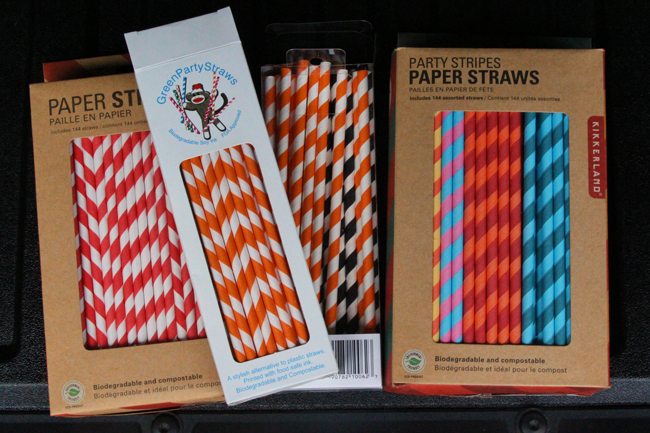After my recent post about mason bee stings, I was surprised by the number of people who wanted to know more about paper straws and where to find them, so here are some of the basics.
- Paper is important. Plastic straws don’t breathe or absorb moisture. This can result in an unhealthy and damp environment, and may even result in the cocoons succumbing to mold or mildew.
- The ink used in paper drinking straws is safe for human consumption, and in any case, it only occurs on the outside of the straws.
- The length of the straws doesn’t matter. You can cut them to fit the length of your container. The bees will only go as deep as they are comfortable, and then they will build a rear partition. I’ve seen them start all the way in the back, and I’ve seen them build only in the mouth of the straw. Usually, it is something in between.
- The straw diameter doesn’t matter much either. If one species doesn’t use it, another one will. In fact, most species are quite adaptable and will use a range of diameters. In the wild, the bees use hollow reeds, berry canes, teasel stems, drain ports, key holes, and beetle borings. None of these things come in standard sizes, so the bees just pick one they like. Anything even close to the diameter of a drinking straw is about perfect.
- Sometimes the straw diameter is marked on the package but usually not. But even when they are marked, it is still confusing. I think some manufacturers list the inside diameter and some the outside diameter. I have quarter-inch straws that are tiny and other quarter-inch straws that are huge. I don’t worry about it. I like to buy a variety of sizes and then mix them up so the bees can take their pick.
- You can line existing tubes with paper straws or you can use the straws by themselves. If a straw seems loose and wiggly inside a tube, I slit another straw longitudinally and wrap it around the first straw to take up the space. I provided instructions for this in an earlier post.
If you are putting the straws directly in a can or other container, pack them tightly enough that the wind doesn’t dislodge them. Sometimes I find tubes pulled partway out of a can. This happens when the bee begins to fly away while her butt is still wedged in the straw. It’s funny to watch, but packing them tightly prevents this as well.
Who will live there?
About thirty percent of bee species live above ground, and many of those species will live in tubes and tunnels including mason bees, leafcutting bees, wool carder bees, and ceratina bees. In addition, a number of solitary wasps including potter wasps and mason wasps will live in the tubes as well. They are all fascinating to watch.
Where to find the straws
I began using paper straws because the tubes sold as “mason bee tubes” are ludicrously expensive. I also think they are a bit too wide. For the mix of bees I have here, I like them just a bit smaller in diameter.
Even though paper straws are cheaper than than purpose-built tubes, they can still be spendy. Sometimes, if I run out of cheap ones, I buy straws through Amazon. Most of the time, I buy straws whenever I see them during the fall and winter, and hope I can collect enough by spring. I often find marked down “clearance” straws after holidays.
For example, I found black-and-orange striped straws after Halloween at Walmart for 25 cents per pack of 50. I discovered red straws with white hearts after Valentine’s Day at Ross at 75 cents per pack. Ross had a huge bin of these things and I only bought a few. Later, I wished and I taken the whole thing because you always need more than you think, and I could always re-sell them. Opportunity lost. I’ve also found them at Michaels and JoAnne Fabrics.
The point is, you never know where they will turn up, but you can be pretty sure you won’t find them when you’re looking for them. Just make them a permanent entry on your shopping list and buy them when you can find them or when the price is right. I do the same thing with sugar: at a good price I’ll buy it any time of year.
Nostalgia for paper straws
I remember in elementary school getting a a half-pint of milk with a paper straw at lunch. By the time you finished the milk, the end of the straw was all collapsed and gummy, saturated with cow’s milk and kid spit. In my wildest imagination I never envisioned writing an article for thousands of readers on how to procure such an odd piece of merchandise. Nor could I have imagined how coveted a rolled up piece of paper could be. Who knew?
Rusty
Honey Bee Suite
 Many of these straws came from Amazon. The price varies all the time, so if it seems too high, check back later.
Many of these straws came from Amazon. The price varies all the time, so if it seems too high, check back later.